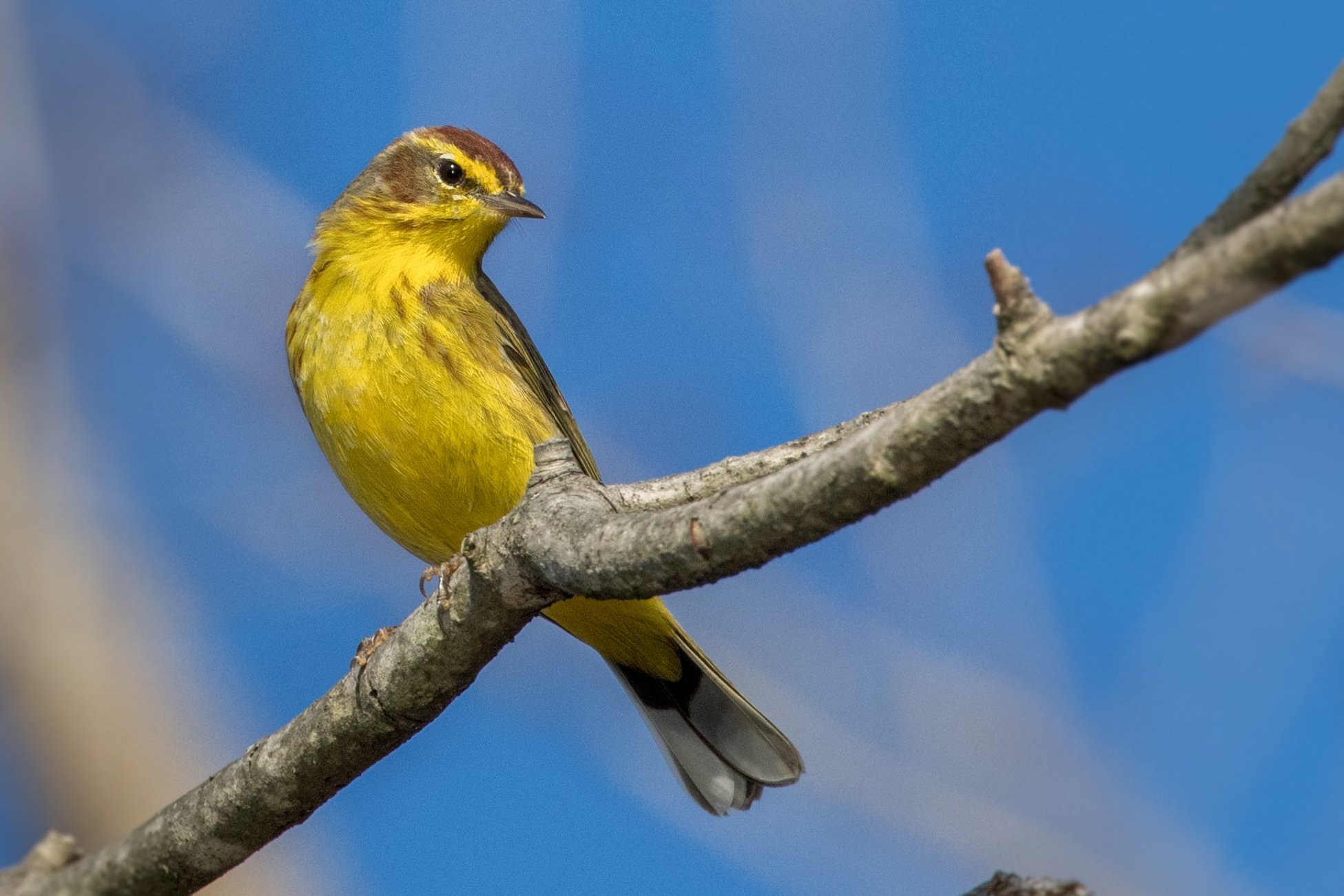|
Audubon's Warbler
Audubon's warbler (''Setophaga auduboni'') is a small bird of the family Parulidae. At one time considered a distinct species, discovery of a hybrid zone between it and the myrtle warbler in 1973 has led to it being classified as a subspecies of the yellow-rumped warbler. Audubon's warbler can be found across western North America, breeding from the U.S. to Canada and wintering in Central America. It is an active bird, often seen flying between branches of trees. In the summer the males have a distinctive yellow throat and a dark head and back. Taxonomy This passerine bird was long known to be closely related to its counterparts Goldman's warbler and myrtle warbler, and at various times the three forms have been classed as either one, two or three species. At present, the American Ornithological Society and Clements considers the myrtle, Audubon's, and Goldman's warbler three subspecies of the yellow-rumped warbler (''Setophaga coronata coronata'' and ''Setophaga coronata audubon ... [...More Info...] [...Related Items...] OR: [Wikipedia] [Google] [Baidu] |
John Kirk Townsend
John Kirk Townsend (August 10, 1809 – February 6, 1851) was an American natural history, naturalist, ornithologist and collector. Townsend was a Quaker born in Philadelphia, the son of Charles Townsend and Priscilla Kirk. He attended Westtown School in West Chester, Pennsylvania and was trained as a physician and pharmacist. He developed an interest in natural history in general and bird collecting in particular. In 1833, he was invited by the botanist Thomas Nuttall to join him on Nathaniel Jarvis Wyeth's second expedition across the Rocky Mountains to the Pacific Ocean. Townsend collected a number of animals new to science. These included birds such as the mountain plover, Vaux's swift, chestnut-collared longspur, black-throated grey warbler, Townsend's warbler and sage thrasher, and a number of mammals such as the Douglas squirrel; several of these were described by John Bachman, Bachman (1839) [...More Info...] [...Related Items...] OR: [Wikipedia] [Google] [Baidu] |
Central America
Central America is a subregion of North America. Its political boundaries are defined as bordering Mexico to the north, Colombia to the southeast, the Caribbean to the east, and the Pacific Ocean to the southwest. Central America is usually defined as consisting of seven countries: Belize, Costa Rica, El Salvador, Guatemala, Honduras, Nicaragua, and Panama. Within Central America is the Mesoamerican biodiversity hotspot, which extends from southern Mexico to southeastern Panama. Due to the presence of several active geologic faults and the Central America Volcanic Arc, there is a high amount of seismic activity in the region, such as volcanic eruptions and earthquakes, which has resulted in death, injury, and property damage. Most of Central America falls under the Isthmo-Colombian cultural area. Before the Spanish expedition of Christopher Columbus' voyages to the Americas, hundreds of indigenous peoples made their homes in the area. From the year 1502 onwards, Spain ... [...More Info...] [...Related Items...] OR: [Wikipedia] [Google] [Baidu] |
Native Birds Of The Western United States
Native may refer to: People * '' Jus sanguinis'', nationality by blood * '' Jus soli'', nationality by location of birth * Indigenous peoples, peoples with a set of specific rights based on their historical ties to a particular territory ** Native Americans (other) In arts and entertainment * Native (band), a French R&B band * Native (comics), a character in the X-Men comics universe * ''Native'' (album), a 2013 album by OneRepublic * ''Native'' (2016 film), a British science fiction film * ''The Native'', a Nigerian music magazine In science * Native (computing), software or data formats supported by a certain system * Native language, the language(s) a person has learned from birth * Native metal, any metal that is found in its metallic form, either pure or as an alloy, in nature * Native species, a species whose presence in a region is the result of only natural processes * List of Australian plants termed "native", whose common name is of the form "native . . . ... [...More Info...] [...Related Items...] OR: [Wikipedia] [Google] [Baidu] |
Setophaga
''Setophaga'' is a genus of birds of the New World warbler family Parulidae. It contains at least 34 species. The ''Setophaga'' warblers are an example of adaptive radiation with the various species using different feeding techniques and often feeding in different parts of the same tree. Most ''Setophaga'' species are long-range migrants, wintering in or near the New World tropics and seasonally migrating to breed in North America. In contrast, two ''Setophaga'' species, the palm warbler and yellow-rumped warbler, have winter ranges that extend along the Atlantic coast of North America as far north as Nova Scotia. The males in breeding plumage are often highly colorful. Etymology The genus name ''Setophaga'' means ''moth eater'' in Ancient Greek; from : ''sēs'' (genitive σητός : ''sētós''), "moth", and : ''phágos'', "eating". Taxonomy The genus ''Setophaga'' was introduced by the English naturalist William Swainson in 1827. The type species was subsequently designat ... [...More Info...] [...Related Items...] OR: [Wikipedia] [Google] [Baidu] |
American Ornithologists' Union
The American Ornithological Society (AOS) is an ornithological organization based in the United States. The society was formed in October 2016 by the merger of the American Ornithologists' Union (AOU) and the Cooper Ornithological Society. Its members are primarily professional ornithologists, although membership is open to anyone with an interest in birds. The society publishes the two scholarly journals, Ornithology' (formerly '' The Auk)'' and Ornithological Applications' (formerly '' The Condor)'' as well as the '' AOS Checklist of North American Birds''. The American Ornithological Society claims the authority to establish standardized English bird names throughout North and South Americas. In 2013, the American Ornithologists' Union (AOU) announced a collaboration with the Cooper Ornithological Society, streamlining operations through joint meetings, a shared publishing office, and a reorientation of their journals. By October 2016, the AOU ceased its independent status, ... [...More Info...] [...Related Items...] OR: [Wikipedia] [Google] [Baidu] |
John James Audubon
John James Audubon (born Jean-Jacques Rabin, April 26, 1785 – January 27, 1851) was a French-American Autodidacticism, self-trained artist, natural history, naturalist, and ornithology, ornithologist. His combined interests in art and ornithology turned into a plan to make a complete pictorial record of all the bird species of North America. He was notable for his extensive studies documenting all types of American birds and for his detailed illustrations, which depicted the birds in their natural habitats. His major work, a color-plate book titled ''The Birds of America'' (1827–1839), is considered one of the finest ornithological works ever completed. Audubon is also known for identifying 25 new species. He is the eponym of the National Audubon Society, and his name adorns a large number of towns, neighborhoods, and streets across the United States. Dozens of scientific names first published by Audubon are still in use by the scientific community. Audubon was accused during ... [...More Info...] [...Related Items...] OR: [Wikipedia] [Google] [Baidu] |
Mono Lake
Mono Lake ( ) is a Salt lake, saline soda lake in Mono County, California, formed at least 760,000 years ago as a terminal lake in an endorheic basin. The lack of an outlet causes Hypersaline lake, high levels of salts to accumulate in the lake which make its water alkalinity, alkaline. The desert lake has an unusually productive ecosystem based on brine shrimp, which thrive in its waters, and provides critical habitat for two million annual migratory birds that feed on the shrimp and alkali flies (''Ephydra hians''). Historically, the native Kucadikadi, Kutzadika'a people ate the alkali flies' pupae, which live in the shallow waters around the edge of the lake. When the city of Los Angeles diverted water from the freshwater streams flowing into the lake, it lowered the lake level, which imperiled the Bird migration, migratory birds. The Mono Lake Committee formed in response and won a legal battle that forced Los Angeles to partially replenish the lake level. Geology Mono Lake ... [...More Info...] [...Related Items...] OR: [Wikipedia] [Google] [Baidu] |
Tufa
Tufa is a variety of limestone formed when carbonate minerals precipitation (chemistry), precipitate out of water in ambient temperature, unheated rivers or lakes. hot spring, Geothermally heated hot springs sometimes produce similar (but less porous) carbonate deposits, which are known as ''travertine'' or ''thermogene travertine''. Tufa is sometimes referred to as ''meteogene travertine''. Classification and features Modern and fossil tufa deposits abound with wetland plants; as such, many tufa deposits are characterised by their large wikt:macrobiology, macrobiological component, and are highly porous. Tufa forms either in fluvial channels or in lacustrine environments. Ford and Pedley (1996) provide a review of tufa systems worldwide. Fluvial deposits Deposits can be classified by their depositional environment (or otherwise by vegetation or petrography, petrographically). Pedley (1990) provides an extensive classification system, which includes the following classes of fl ... [...More Info...] [...Related Items...] OR: [Wikipedia] [Google] [Baidu] |
Conifer
Conifers () are a group of conifer cone, cone-bearing Spermatophyte, seed plants, a subset of gymnosperms. Scientifically, they make up the phylum, division Pinophyta (), also known as Coniferophyta () or Coniferae. The division contains a single extant class (biology), class, Pinopsida. All Neontology, extant conifers are perennial plant, perennial woody plants with secondary growth. The majority are trees, though a few are shrubs. Examples include Cedrus, cedars, Pseudotsuga, Douglas-firs, Cupressaceae, cypresses, firs, junipers, Agathis, kauri, larches, pines, Tsuga, hemlocks, Sequoioideae, redwoods, spruces, and Taxaceae, yews.Campbell, Reece, "Phylum Coniferophyta". ''Biology''. 7th ed. 2005. Print. p. 595. As of 2002, Pinophyta contained seven families, 60 to 65 genera, and more than 600 living species. Although the total number of species is relatively small, conifers are ecology, ecologically important. They are the dominant plants over large areas of land, most notably ... [...More Info...] [...Related Items...] OR: [Wikipedia] [Google] [Baidu] |
Bird Migration
Bird migration is a seasonal movement of birds between breeding and wintering grounds that occurs twice a year. It is typically from north to south or from south to north. Animal migration, Migration is inherently risky, due to predation and mortality. The Arctic tern holds the long-distance migration record for birds, travelling between Arctic breeding grounds and the Antarctic each year. Some species of Procellariiformes, tubenoses, such as albatrosses, circle the Earth, flying over the southern oceans, while others such as Manx shearwaters migrate between their northern breeding grounds and the southern ocean. Shorter migrations are common, while longer ones are not. The shorter migrations include altitudinal migrations on mountains, including the Andes and Himalayas. The timing of migration seems to be controlled primarily by changes in day length. Migrating birds navigate using celestial cues from the Sun and stars, the Earth's magnetic field, and mental maps. Histor ... [...More Info...] [...Related Items...] OR: [Wikipedia] [Google] [Baidu] |
Bird
Birds are a group of warm-blooded vertebrates constituting the class (biology), class Aves (), characterised by feathers, toothless beaked jaws, the Oviparity, laying of Eggshell, hard-shelled eggs, a high Metabolism, metabolic rate, a four-chambered heart, and a strong yet lightweight Bird skeleton, skeleton. Birds live worldwide and range in size from the bee hummingbird to the common ostrich. There are over 11,000 living species and they are split into 44 Order (biology), orders. More than half are passerine or "perching" birds. Birds have Bird wing, wings whose development varies according to species; the only known groups without wings are the extinct moa and elephant birds. Wings, which are modified forelimbs, gave birds the ability to fly, although further evolution has led to the Flightless bird, loss of flight in some birds, including ratites, penguins, and diverse endemism, endemic island species. The digestive and respiratory systems of birds are also uniquely a ... [...More Info...] [...Related Items...] OR: [Wikipedia] [Google] [Baidu] |






